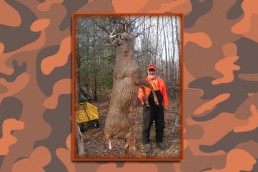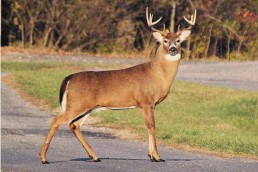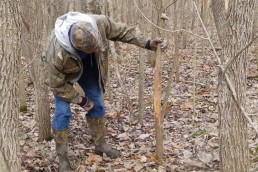Secrets to ‘Speaking Deer’ and Luring in Big Bucks
SHARE THIS POST
We pursue deer through many methods: hunting from elevated stands, ground blinds and stalking. Our efforts make it obvious we are usually chasing deer. But can we reverse our roll and tempt the deer to hunt us?
Whenever we rely upon deer-related communicative sounds, they will seek us out and provide hunting opportunities not always available. Before the rut is in full swing, deer are fairly silent; they don’t vocalize much. But when the rut explodes, they become “talkers,” with the bucks making “grunts” and does with their “bleats.” It doesn’t matter where we hunt, vocalizing with deer works. This human hunting “ploy” will always be effective because deer are vocal communicators, at least within their social structure.
Enticing bucks to hunt you by using their language is based upon timing, and is similar to calling gobblers during spring mating. When toms are sexually energetic, they respond to various vocals. The bucks are too, when in sexual overdrive. These communicative sounds “turn on” the bucks, making them intent on finding the source of the vocals. Remember, as with all forms of game calling, one day nothing may happen then the next day they may respond quickly in numbers. And the more often you use these communicative sounds, the better your odds.
Hunters who implement vocalizations and antler rattling have an advantage because deer consider these sounds “natural.” It’s like speaking two different languages—even though we’re attempting to sell the reality of whitetail lingo, it’s either the right time, or it isn’t. But it can work, and if hunters apply initiative and frequent use, even a trophy hunter can be selective with shot choice and the animal’s size.
There’s no mystery to creating doe bleats, buck grunts and antler rattling. Unfortunately, many fail to incorporate these sounds. Ideally, active scrapes, territorial rub areas and active feeding spots are hunting ambush locations. But in deer habitat, the animals sometimes respond just out of curiosity. Select a corridor trail leading from a bedding area or feeding spot and you’ll have locations to call an inquisitive buck or curious doe.
Consider that during normal hunting situations we’re trying to find deer. They have the odds in their favor because we have entered their habitat. However, we can alter the way we persuade them to come nearer. Vocalizing helps reduce “chance” results, and mimicking doe bleats can attract does as well as bucks. Grunting with a grunt tube and creating fake fighting by rattling antlers together will attract the bucks, and even some inventive hunters create rattling bags and call boxes that mimic many deer sounds.
Are you enjoying this post?
You can be among the first to get the latest info on where to go, what to use and how to use it!
There are many vocal calls at your disposal. Often, using two or three allows hunters to select one that works well for their abilities and hunting style. A few calls resemble buck grunts, a snort wheeze or doe bleats. Learning which to use will improve your results, but don’t stop experimenting. Doe bleats mixed with buck grunting can reinforce the notion a doe and buck are in a breeding frenzy. Deer react during the weeks of prime rut behavior, and the mature bucks respond frequently, often with a noticeable aggression. Although a breeder won’t be a pushover, creating realistic vocals can tease it within shooting range.
Grunt tube designs hinge on the principle of a flexible tube attached to a tubular sound chamber fitted with a sound- producing reed. They operate when placed at one’s mouth and expelling short bursts of air through the tube. Blowing with a “huff-huff-huff” cadence produces grunting tones, which somewhat resemble the grunting of a domestic pig. Created grunt sounds don’t need to be “forcefully” loud because natural buck grunting is usually low-toned. And, it’s more effective to keep the cadence minimal because bucks can hear well from great distances. If they are too loud or too frequent, bucks will become suspicious and then may pinpoint your exact location. Usually, once you spot a buck responding stop calling, unless you need to add two or three soft, teasing grunts. Make him search the area for what he considers is another buck.
Antler rattling simulates two or more bucks in conflict when jousting for territorial rights or doe “control.” Rattling intensity varies with the level of breeding activities. Before and after the rut peak, gently ticking rack tines tips together can tease the bucks and force them to investigate. If they don’t respond, go “slam” the racks together as if two bucks are in an intense battle. When bucks are mesmerized by the estrus does, cracking, banging and slapping two racks together works wonders. Bucks often respond, but a wary buck will often sneak in and circle your position, downwind. Be very alert when rattling because bucks aren’t fools, even when they desire does.
There aren’t stringent guidelines when vocalizing and rattling; it’s up to a hunter to be creative. Try about any sequence and determine what works during the rut. Use logic and imagine how it would sound if two bucks were actually fighting, and begin your vocals and rattling slowly and passively—they may be very close and you don’t want to spook them away with aggressive sounds. Watch the landscape carefully, and if there’s no response within 10 minutes, work harder with louder, more aggressive sounds. Many give up when deer don’t respond, but that doesn’t mean they haven’t heard you. They might not be interested because of the breeding mode, but again, when bucks are ready to respond be organized and alert because they can either sneak into your stand location or run in like a world-class sprinter.
Antler rattling and deer vocalizing are natural sounds that can change the course of a hunts. You can attract bucks through curiosity, aggression and sexual “interest.” Consider that when we hunt free-ranging white-tailed bucks that we usually rely on chance. But if hunters concentrate on the “sounds” of the season when deer are mating, the results can be successful because bucks will want to “hunt” you if you converse with them.
MWO
SHARE THIS POST
Did you enjoy this post?
You can be among the first to get the latest info on where to go, what to use and how to use it!
Bob Grewell
Bob “Greenie” Grewell has written about and photographed the outdoors for 40 years. He’s travelled throughout the U.S., Canada, the Arctic Circle, as well as Germany and Denmark. He has written a book on hunting dogs and contributed articles and photography to others. He currently focuses on deer and turkey articles, and wildlife photography.



